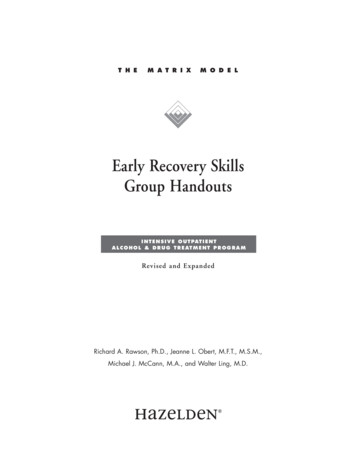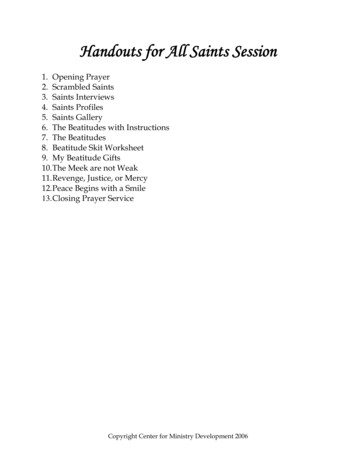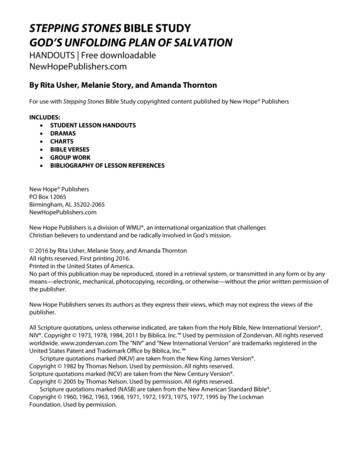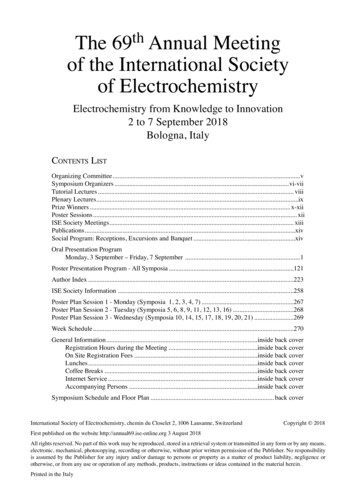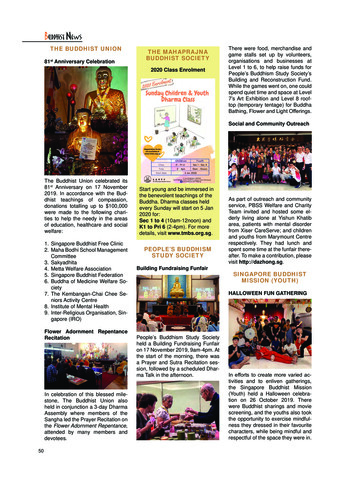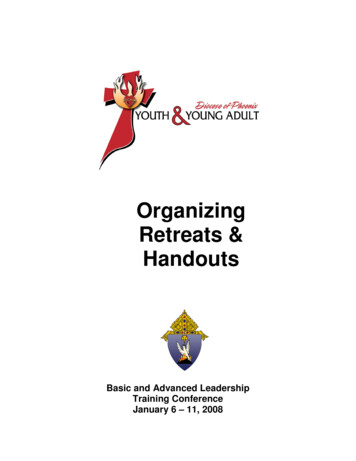
Transcription
OrganizingRetreats &HandoutsBasic and Advanced LeadershipTraining ConferenceJanuary 6 – 11, 2008
Diocese of PhoenixPreparing Your Retreat:Table of Contents1Organizing for Retreats2What Is A Retreat?PrayerWhere to Have Your Retreat?Theme / TopicsPreparing a Retreat ScheduleIcebreakersPreparing Sessions: Talks & TestimoniesCreating Small GroupsHow Will We Attract Teens To Attend?TransportationHow Will Pay for it All?23455668101112The Retreat in Action12Administrative Notes21Role of the Family21Role of the Parish Community22Retreats: The Work of the Holy Spirit22Prayer in Union with Jesus22Handout #1: Retreat Centers23Handout #2: Retreat Template25Handout #3 Resources for Icebreakers, Community Builders & Games28Handout #4: Transportation / Insurance Policies29Handout #5: Driver Information Sheet31Handout #632Diocese of Phoenix General Retreat Consent FormsHandout #7: Liturgy Worksheet35Handout #8Letter to Parents36Handout #9: Checklist for Retreat Directors37Handout #10: Basic First-Aid Kit38Handout #11: Chaperon Policy391
Organizing for RetreatsRetreats, like no other activity, provide us, as Directors and Coordinators of YouthEvangelization and our youth ministry teams, the opportunity to engage our youth inthe most important of all conversations. Retreats serve as an excellent vehicle to getteens away from the many distractions of their day in order for them to help focus anddevelop their relationship with Jesus Christ, and come to a deeper understanding of theteachings of the Catholic Church. Over the course of my experience in the evangelizationof youth, I have seen more conversion take place as a result of teens encountering ourLord on retreats than almost any other activity provided. Retreats offer our teens avariety of profound, and shared spiritual encounters of the living Jesus Christ. Throughreceiving reconciliation, the Eucharist, participating in various forms of daily prayer,hearing the Word of God preached, and being challenged and formed to deepen theirrelationship with Christ, many for the first time, come to make life-long decisions tofollow Jesus. Retreats also give you, as Youth Leaders, and your team, a concentratedopportunity for leading the teens you have worked with throughout the year into arelationship with Christ. Also, your team members, as well as the teens themselves, arealso able to experience His love through the relationships that can be found in theparish community which are formed as a result of these retreats. Retreats help bring ourteens into an encounter with the living Christ – therefore – they are a must in the workof youth evangelization! Pope John Paul II says it this way:Young people are a great force in society and for evangelization. On theirencounter with the living Christ depends the hope and expectation of a future ofgreater communion and solidarity for the Church and society in America (EA #47.)What is a retreat?A retreat at a time when your youth group goes away for a weekend, usually a Fridaynight till late Sunday afternoon and has many opportunities for fun, outdoor activities,times for transformational experiences that lead into an encounter with Christ, andformation teachings given either by your youth group team or a guest speaker thatchallenges them as they evaluate their own relationship with Jesus and His Church.Every parish retreat and youth group is unique. The plans that may have worked at lastfall’s retreat may not work for this year’s spring retreat. Every group at every retreatmust be handled differently, however we can make basic plans by asking ourselvesseveral key questions:What is our goal? What would we like to see accomplished as a result of this retreat?Who are we trying to address? Are they church going teens or are they un-churchedteens? What types of fun will they enjoy? These and a dozen other questions will helpus clarify our goals.2
The goal of the retreat must fit in with the overall plan for our youth evangelizationefforts. As a yearly schedule is produced, we must see retreats as fitting into otheractivities and programs. For example, when I was at Our Lady of Mt. Carmel, our youthgroup held three retreats each year: the fall retreat was designed to help welcomenewcomers and also had a very pre-evangelistic and evangelistic emphasis. I used it asan evangelistic tool that helped our teens invite their friends to hear the basic Gospelmessage; the spring retreat became a discipleship retreat that specialized in formingthose who were serious about their relationship with Jesus Christ and focused ondiscipleship, apologetics and leadership training. In the summer I took our teens to theSteubenville West conference as another evangelization type retreat. Also, during thesummer I took advantage of offered discipleship weeks, and mission trips.Set realistic goals for the retreat and do not expect a retreat to be the miraculous curefor problems within your group. In some respects, a positive retreat is a result of, notthe cause of, ongoing youth group health.Youth retreats can accomplish several goals:A. Reaching out to the un-churched.B. Building youth group identity and communityC. Catholic discipleship / leadership trainingD. Rest and relaxationE. Making great positive memoriesF. Opportunities for teens to ask those tough questions about GodG. Modeling of the Christian lifeH. Preparing future leadersMuch of the success of retreats depends on how well organized your plan is way beforethe retreat begins. There is a great deal of preparation that needs to be well thoughtout, organized and prayed through such as the purpose of the retreat, its theme, thosewho will be working with you on the team, reserving the retreat center or camp site,transporting teens safely, preparing the retreat schedule and much more. This sectionof Youth Evangelization will give you a step by step process in helping you to organizethe varied aspects of preparing for a successful retreat experience for your youth.PrayerPrayer has got to be top on the priority list in the first step to planning your retreat. Itwill be through your prayer that you will seek the mind of Christ and hear his voice bythe power of the Holy Spirit, through out your planning process.Among the forms of sharing, first place goes to spiritual cooperation throughprayer .Prayer should accompany the journey of missionaries so that theproclamation of the word will be effective through God’s grace (RM. #78).This is important because any success in spreading the Gospel message during a retreatrequires faith, and faith comes only as a free gift from God. So we are truly only3
instruments of the Holy Spirit’s work, working in and through us. Pope John Paul II goeson: “The mission of the Church, like that of Jesus, is God’s work, or as Luke often puts it,the work of the Spirit” (24). “Mission, then, is based not on human abilities but on thepower of the risen Lord”(23).Before any of the most important decisions Jesus had to make, he prayed. He prayedbefore he choose his twelve apostles (Luke 12:6); before promising his body and bloodas food and drink (Jn. 6:15), He prayed before choosing Peter to build his Church (Matt6: 18); and He prayed in agony before he was to die in the Garden (Matt 26:36). Theseexamples tell us that transformation and conversion is a work of God and therefore canbe accomplished only by the graces we receive in prayer. As Jesus prayed so must we!Taking Jesus example, practically means we must pray before we select those to be onour retreat team, for his wisdom in selecting a theme, defining what we would like toaccomplish, a theme song, topics for sessions, talks, guidance in choosing the rightpeople to give the talks, what spiritual exercises we should use, small groupings, thegames and icebreakers to be used and most of all pray that God will send His Holy Spiritto begin touching the hearts of those He will call to be on that retreat and that all on willinstruments of God’s grace and love. Scheduling times of prayer for this retreat shouldcontinue throughout the whole retreat experience from the beginning of the planningto the end, keeping in mind to continue in prayer for all participants as God prompts.Where to have your retreat?If you have not yet planned a retreat before it is good to know that there are manyretreat centers through out Arizona from which to choose from (See Retreat Centers –Handout #1).There are nine retreat centers in the Diocese of Phoenix that are Catholic owned andoperated. These are: Living Water Retreat Center - Cornville, AZ., LIFE TEEN Tepeyac inPrescott, AZ., St. Joseph's Youth Camp – Flagstaff, AZ., owned by the Knights ofColumbus, The Casa, Franciscan Renewal Center - Scottsdale, House of Joseph Retreat& Conference Center – Yarnell, Catholic Community Retreat Center – Flagstaff, MountClaret Center – Phoenix, The Hillman Center – Phoenix, Our Lady of SolitudeContemplative House of Prayer – Black Canyon City. This point is important in that allhave chapels and everything you need in order to have Catholic prayer services,Liturgies and Adoration of the Blessed Sacrament. The following are suggestions to keepin mind as you choose a retreat center for your next retreat:How many participants do you expect on your retreat?Understanding the numbers can help you in determining the type of place you need,how many busses to order, beds, breakout places, how much room for presentations, isthe chapel large enough for all to be in?At this facility – will there be other groups there at the same time your group is there?Knowing this is a must in your scheduling. You may have to share spaces at alternate4
times, such as meal times. If so, how will this impact grace, clean up and any kind ofdecorations you may want to put up to celebrate a special meal such as a Lord’s Day,birthday, or even a coffee shop, etc? You may want to find out who this group is and seeif they will be alright with you being there.Know where all their various facilities are and if you are free to use them as you need.There are some facilities that may need to be pre-arranged like a chapel, ropes course,fire pit, pool or special rooms for adoration and/or prayer. Make sure to find out if thereare any additional fees in arranging special facilities. Are these facilities within theretreat center big enough for all your participants to use at the same time?Theme / TopicsIt is a good idea to give retreats names so as to have each retreat reflect its ownidentity. The name is drawn from the theme, which sets the foundation for thedirection of the retreat. The choices available for selecting a theme are only limited bythe imagination of you and your team. Many have used song titles, book titles, movietitles, quotes, current events, play on words or catch phrases that are common of theday, and of course scripture passages. With this in mind, it is important that you do notfeel hindered by the theme and lyrics of song to accomplish the goal of the retreat.In selecting a theme and name for your retreat know what you and our Lord want toaccomplish on this particular retreat. For example, if you believe through prayer yourteens need a better understanding of the Eucharist, ask yourself what would be a catchytitle that would capture the imagination of the youth you want to attend. Here are tworetreat titles I have used in the past for this topic: Better than Gold (this was before theOlympic Games one year), Extreme Presence (when everything was extreme). Anotheridea in selecting a theme is to read and pray about the daily liturgical reading schedulefor all the days of the retreat. Look at liturgical calendar for ideas.Preparing a Retreat ScheduleThe retreat schedule template (Handout #2) can be used in coordinating retreats. Feelfree to use this as a template in preparing for your up-and-coming retreat.Important things to keep in mind as we plan our retreat schedule: It is important to look at the overall flow of the retreat. Look at such things aswhere we put reconciliation in relation to the Mass and those sessions that willhelp prepare our teens for full participation in the Mass. It is important to account for every minute of our retreat, but at the same time,we must allow the Holy Spirit to do His work and not be a slave to the schedule.Let us use the scheduled as a tool for what God wants to do at this retreat. Is important to know how long each talk will take in the context of each of thesessions. (You set the parameters) It is important to look at the facility and to account for the time it would take tomove teens from one facility to another; such as the time it takes teens to leave5
their cabins to go to the retreat meeting place or to leave their cabins to go tothe cafeteria, etc. It is important when doing activities such as messy games to anticipate how long theparticipants will need to take a shower before they need to be at their next activity orsession. (See Handout #2 as example of a retreat template).IcebreakersPurpose of Ice Breakers & Community BuildersEverything we do on a retreat has to have a purpose. Icebreakers, community buildersand games are all very important elements of a retreat. There are all sorts of books andresources that can help give you ideas in the implementation of icebreakers, communitybuilders and games, however, all of those books are only as helpful as you know how touse them in a retreat setting. The best reason to use one of these icebreakers orcommunity builders is to fill a specific need.What is the difference between icebreakers, community builders, and games? Are theynot just fun and games? The answer is, yes and no. The difference is what you use andhow you use it. Icebreakers are meant to do exactly as the name implies – break the ice.It does not matter how close your group is to each other, you will still need to do someicebreakers. After a long bus ride to the retreat center, with teens that are limited totalking to a just few people sitting near them, icebreakers start the whole group onequal footing. They also help bring out the introverts in a safe, large group setting. Andicebreakers are also helpful to those teens that are new to the community and enablethem to meet people in a playful environment. The objective of icebreakers is to helpinstill a feeling of ease and comfort in the retreat and group setting.The big difference in icebreakers is between large group and small-group icebreakers.The large group icebreaker should be fun, upbeat, and get the kids up and moving tomeet people. And small-group icebreakers should be fun as well, but restricted togames or activities that the group can do together. The line between the two is veryfine, but they both worked for the same goal of building trust and a sense of securitywith the people they will be sharing with over the course of the retreat. The differencebetween the two is intensity of the games or activities. (See Handout # 3 – Resources)Preparing Sessions: Talks and TestimoniesAs Director of Youth Ministry at the parish, you are responsible for the team, so you arethe one who will assign the talks to team members, unless you do them yourself. Themost important factors in preparing a retreat talk are three key elements. These arescope, focus, and target. After we look at preparation and how to write a presentation,we will look at these very important elements.The first thing to do in preparing a talk is to pray to God for inspiration. We can trust inthe Holy Spirit, and His guidance in giving to us what we need to select the appropriateconcepts and words to convey His message. We must allow God to do work within us in6
the preparation of the talk. The next thing to do is to begin to outline three or fourpoints that must be communicated.From the outline, start writing your talk, word for word. Once it is written, read it outloud three or four times, making changes and corrections as you go along, until it feelsright. Then, begin to time yourself. After revisions, practice your final draft two orthree times so you can be sure you know the material. Then, begin to reverse theprocess. From the final draft write a new outline, and then transfer the sections of youroutline into notes that will serve you as you give your talk on the retreat. Some peopleuse note-cards that help people be focused and to keep on track. It is important toknow in giving an effective talk it will take a great commitment and a lot of work. Alsopractice giving your talk over and over again so that you learn it and know how toemphasize certain points when they need to be emphasized. This helps with the flow inthe presentation.Scope, Focus, and Target - Keys in helping to put clarity to the content of the talk.The first step in determining the content of presentation is to set limits on the scopeof the talk. A presentation on the relationships, for example, is too broad. The scopeshould be limited to one or two types of relationships. Limitations are determined byasking a few key questions:What is the average age of those on the retreat?What are the needs of the group?What are the expectations of the group?What is the history of the group?What is the size of the group?Some of these questions maybe hard to answer if you have never worked with thisgroup of teens before. If so, the two most important questions you can ask in helping toset the scope for the talk is to cover the group’s needs and expectations.FocusBy setting the focus of the presentation we are choosing the central theme. If we limitthe scope of the relation talk, for example, to “Relationships between best friends”, ourfocus then can be on the qualities found in a best friend. The focus must be brief andclear to keep the imaginations of the teens from going off in different directions. If weallow the focus to be too broad, the talk can become aimless and boring. Keep thecontent in focus. Any examples and personal sharing of friendships by the presentersshould also stay within the focus of the presentation.TargetClarifying the target of the presentation is the most difficult, yet important aspect ofpreparing a talk. If the presenter can target the main message of the talk and thenexpresses in a phrase that is repeated in a few different ways during the retreat7
presentation, then hopefully all the teens get the same message from the talk. The goalis to hit the bull’s-eye several times during a presentation to get the target point across.Creating Small GroupsSmall groups play an important part in the process of the retreat. When planned andimplemented properly, the experience of community that is created in small groups cancarry over far after the retreat is over and to the entire weekly Youth Group gatherings.The importance of this is IMMENSE! If our young people can experience a sense ofbelonging in small groups on a retreat, then youth will want to continue to belong to thecommunity at large, and therefore will stay active in YOUR PARISH youth ministryprogram after the retreat experience is over.Two important variables to consider in creating small groups are size and mix. Creating asmall group should never be done by chance or at last minute. Names should not berandomly drawn from a hat.Your team should play an active role in breaking the young people into small groups.This is important because in many cases they have known many of the teens for years.They have insights into the relationships and current situations that the youth ministercould never know. Many of the adults on your team may have knowledge that is alsohelpful in this process. Variables to keep in mind when defining small groups: Determine if you want to have boys and girls in separate groupings. If you decide to mix of boys and girls keep a balance in the group. Divide older 11th and 12th grade students among all the groups. This helps withhaving experienced retreat since with younger teens. Their age and experiencehelps set the tone in the group, and can be an unspoken prompt to the youngerteens to behave in a more mature fashion. Participants also gain much from thesharing of younger and older members, in learning how the Lord works in theireveryday life. Do not put best friends together in the same group. This also goes forboyfriends and girlfriends. Separate siblings. Additionally, if you have a parent of a teen on the team, donot put the parent and child in the same group. The child will speak more freelyin a group that does not include his or her parent. Key personalities! Try to keep a balance in the groups between introverts andextroverts. Your team will appreciate this!NOTE: You may have someone you perceive that may have a problem in small groups,whether due to behavioral problems or due to a unique situation in that teen’s life;recent death in the family, etc. If so, make sure you put that person in a group with8
adult team leader with retreat experience and who you think has the best perceptionand sensitivity to work with that person.The ratio of team membersDepending on where your group is meeting will depend on how many core membersyou have in each group. The diocesan guideline for ratio between adult core membersper teen is two adult team members up to 10 teens for the first 10, and one to 10 afterthat. This means if your adults are meeting in a secluded or isolated place such as acabin you must have at least two adults in your small group whether your group is oneteen or 10 teens. If however your small group is meeting in the hall with other smallgroups, though it is still wise to have two adult leaders per group, the other adults in thehall would suffice to stay in compliance with the Safe Environment policies of theDiocese of Phoenix. Another reason for having two adult group leaders is if one teammember gets sick during the retreat, there is another member to facilitate the group.With that said, as a rule of thumb I would never have a group larger than nine people,including two adult team members.Leading small group discussionsSmall group discussions are among the most important aspects of any retreat. Afteryour teens have heard the teachings on the particular topics it is now time to processwhat they had just heard and begin to apply this information to everyday life. This timespent in small groups allows the participants to express their reflections, apply this totheir life and discover how others respond to the same topics.The small group facilitator should be trained well for this very important task. It isimportant that the teens are comfortable and feel that they are in a safe environment insharing their reflections. We want the teens to feel free to be themselves and to sharetheir feelings without being challenged. They need to be in an environment based ontrust, freedom, affirmation and acceptance with out the fear of being judged.The facilitator’s role is to provide this type of environment for this level of sharing tooccur. The facilitator creates this atmosphere by sharing from the heart, and then notby judging, evaluating, interrupting, or criticizing the teens sharing. The facilitatorshould also be a model for the group in attitude posture, mannerisms, and in words.They should be encouraging and affirming as they listen attentively.This may all seem obvious, but this does not necessarily come naturally to everyone.The following are some ways that can help the facilitator achieve this level of smallgroup sharing. Listed below are a few of the do’s and don’ts for small group facilitators.Make sure your facilitators know these well and go over them before the retreat begins.Do ‘sDo begin and end with prayerDo have everyone introduced to each otherDo understand the topic of discussion and be familiar with the small group questionsDo stick to the topic9
Do accept people for who they areDo smile; nod your head, etc.Do look a the person sharing in the eyeDo begin the sharing by you sharing yourselfDo trust in the Holy Spirit to lead youDo make people feel exceptedDo thank the teens for sharing with the rest of the groupDo give everyone a chance to shareDon’tsDo not stray from the topicDo not judgeDo not be criticalDo not let your attention wanderDid not lectureDo not count on self – but on the Holy SpiritDo not interruptDo not shuffle too much or let you recipients get up and stretchDo not let any one talk too much and take time away from the othersDo not leave anyone outPreparing a PresentationHow Will We Attract Teens To Attend?Creative flyers, retreat brochures, and handouts are all good recruiting or advertisingtools. Church bulletins, mailers, e-mail and web sites can remind families and posterscan remind students to plan ahead.But the best way to get teens to attend retreats is personal contact. Phone calls madefrom your parish office phone that are personal invitations can really encouragestudents to come. Personal recruiting like this should be delegated to yourevangelization teams using the parish phones and to responsible teen leaders so thatnewcomers will be well cared for on the retreat. If I invite 15 new teens to the retreatand they all come, they will expect me to make them feel welcome and comfortable. Itis unlikely that I can do this well. We do not want to have teens have a bad retreatexperience because we were not attentive to their needs. It is far better for me to get14 others to help me invite people. This way the new people who come have oneguaranteed person who can be their personal host on the weekend.As you will plan recruitment, be aware that some teens and parents are notoriously badplanners: they register at the last minute, sometimes even as the bus is preparing to leave. Thismakes coordinating all the logistics for the retreat very difficult. Offering financial discounts forearly registration or penalties for late registration and setting in attendance limit may help avoidlast-minute registrations. We have considered rejecting last-minute registrations, but itsometimes has put us in the position of rejecting the students who most need to go on theretreat.10
TransportationPlanning properly for the transportation to and from the retreat is vital if you want toavoid all kinds of problems.Before deciding on whether or not to charter a bus or have parents or volunteerstransport the teens to the retreat site, refer to the Diocese of Phoenix TransportationPolicy and talk the options over with your pastor. (Refer to Handout #4 for the Dioceseof Phoenix Transportation Policy).If your parish can afford this you and your parish is, liability wise, much better off inchartering a bus than having parents or volunteer adults drive teens to and from theretreat.Bus TransportationIf you are taking a bus, start as soon as you can to shop for quotes. Try to do this at leastsix months out from the retreat date. There is great wisdom in getting at least threequotes to give you an idea how to budget transportation costs for this retreat. Thefollowing are bus companies that come highly recommended, but be sure to compareprices:Laidlaw Bus Lines,Southwest Charter Lines,Arrow Bus Lines (Coach USA/Gray Line Charter)All Aboard AmericaRoadrunner Bus LinesParadise Valley Bus 6202602-272-2770602-256-0101Have the following already decided before you make that call to the bus companies:Know the size of the bus you want to rent. Try your best to estimate the number ofteens who will be going on this retreat and only pay for that many seats. There are 55,and 45 passenger seats. Know how many seats you need.Questions to ask the bus company:Will the bus driver allow you to help with loading and unloading of the luggage?What will the company do if the bus breaks down?Will the company bill you, or will you need to pay the driver with a check?Does the company allow you to bring food on the bus?Private VehiclesIf you choose to use private vehicles using parents vans or other adult drivers ask thefollowing questions:Are the drivers at least 25 years old?Do you have insurance? (Refer to insurance policy - See handout #4).How many seat-belts are working in the vehicle? This will tell you how many youcan have in that vehicle!Can they drive both ways?11
Have all drivers meet at the church, even if they are picking up all their passengers atanother location, like a school. Always let drivers know up front what is expected ofthem regarding timing and responsibilities. Provide the drivers with directions to andfrom the retreat center, medical release forms for each passenger, and phone numbersof a contact at the parish and at the retreat center in case of an emergency. Also, havethem fill-out and give to you a Drivers Information Sheet (See handout #5).To avoid any last-minute surprises, call your bus company and or adult drivers two (2)days before you plan to leave for the retreat to confirm all arrangements.How will we pay for it all?Assuming the retreat will pay for itself, what are the costs? In calculating the per personcosts, consider the cost of the following:A. Renting the facilityB. Food and its preparationC. TransportationD. The speaker consider travel food lodging and StipendE. Core or Leadership Team members if they are giving up a weekend to minister,we like to cover their costs or part of it; if we do this, the student fee mustabsorb it, promotional brochures printing mailings etc.F. Retreat entertainment supplies for skits rentals for movies etc.G. Scholarships if we want to sponsor students who can not afford to go. We mustbuild in our reservesH. Insurance – check to see if the church has to take out special insuranceObviously if all these items are factored into the retreat costs, teams would never beable to afford the retreat. The best alternative is to factor some of the retreat budgetinto a regular budget.The Retreat in ActionTeens arrive at the ChurchBefore your teens are due to show up, have a greeting team arrive at the church aboutthirty minutes before. This gives them ti
C. Catholic discipleship / leadership training D. Rest and relaxation E. Making great positive memories F. Opportunities for teens to ask those tough questions about God G. Modeling of the Christian life H. Preparing future leaders Much of the success of retreats depends on how w

